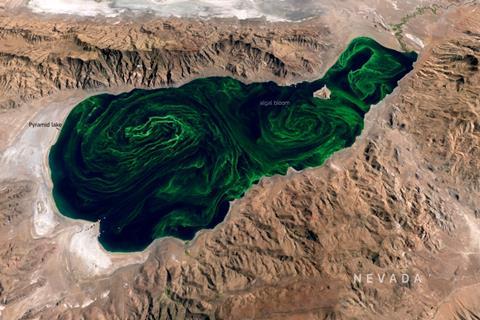With climate change affecting algal blooms, researchers have discovered that the combined nutrient and meteorological factors have significant influence on bloom frequency in large lakes across the world.
Algal blooms were present in nearly half of the world’s 1956 large lakes. Geographic analysis reveals significant regional variations, with European lakes facing the most severe bloom problems, followed by North America. Subtropical and South American lakes, along with those in East Africa, have also seen frequent blooms. Smaller lakes (<1000 km²) had a higher frequency of blooms, with larger lakes predominantly experiencing blooms in shallow, nearshore areas.

Of the 620 lakes with more than 10 years of algal bloom records, 504 lakes showed an increasing trend in bloom frequency, and the global median annual bloom frequency has increased significantly at a rate of +1.8% per year over the past two decades. The increasing trend was particularly pronounced in the subtropics, where 51.9% of lakes showed a significant increase in algal bloom frequency and only 11.1% showed a decreasing trend.
In contrast, the increasing trend was relatively weak in the tropics (+1.4%/year). Temporally, the increase in global lake bloom frequency occurs mainly after 2015, with a median relative growth rate four times faster in the period 2016-2022 (+4.6%/year) than in the period 2003-2015 (+1.1%/year).
Meteorological factors
The mean annual frequency of algal bloom outbreaks in bloom-affected lakes showed a strong correlation with mean air temperature fluctuations from 2003-2022, with correlation coefficients as high as 0.43 (P<0.05). In 44.8% of the algal bloom-affected lakes, the correlation between daily air temperature and bloom frequency was stronger than other meteorological parameters (precipitation and wind speed) and nutrient concentrations.
READ MORE: ‘Regular testing needed’ following massive blue green algal bloom in UK’s largest lake
With temperatures exceeding 20°C, 59.4% of bloom events occurred, indicating that warmer climate conditions provide optimal environments for algae growth and reproduction. While other meteorological factors like rainfall and wind speed also influence bloom frequency, their impact is much less significant compared to temperature.
Nutrient factors
Furthermore, nutrient inputs, particularly nitrogen from agriculture and livestock, are significantly correlated with bloom frequency. “In lakes where bloom frequency did not significantly correlate with nutrient usage, this could be because current saturated nutrient input levels may no longer be the primary limiting factor due to excessive nutrient inputs, internal nutrient recycling, or legacy nutrient loading. Another possible explanation is that algal blooms may result from the combined influence of various meteorological and nutrient factors, where a significant correlation with bloom frequency might not be apparent for any single factor alone” Dr. Lian Feng says.
Overall, the study, published in National Science Review, emphasizes the amplifying effect of climate warming on algal blooms, particularly in high-latitude lakes. Although the research focuses on large lakes, smaller lakes also experience similar bloom trends. The monitoring data is essential for understanding environmental degradation and its impacts on ecosystems, human health, and socio-economics, aiding in the development of effective strategies to address this growing challenge and support the United Nations’ sustainable development goals.







No comments yet